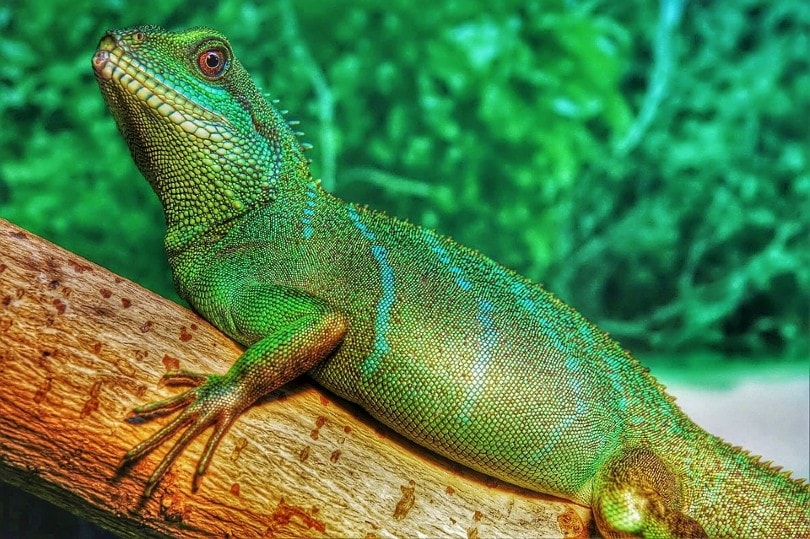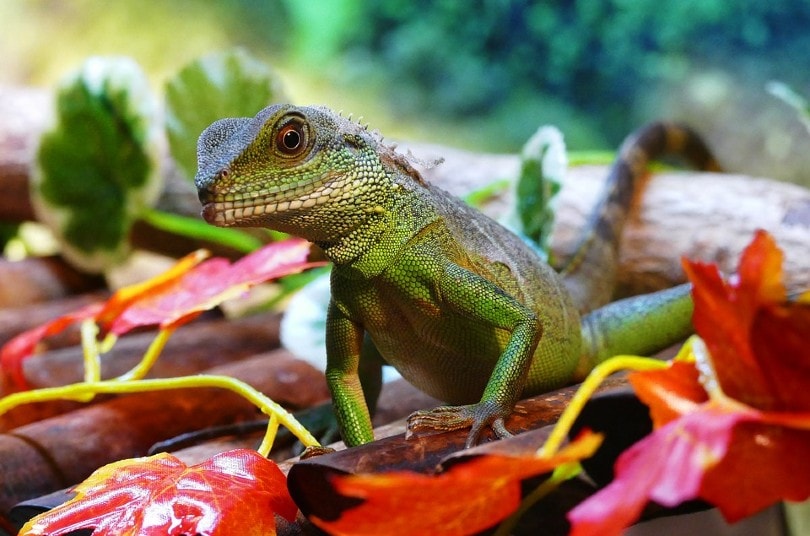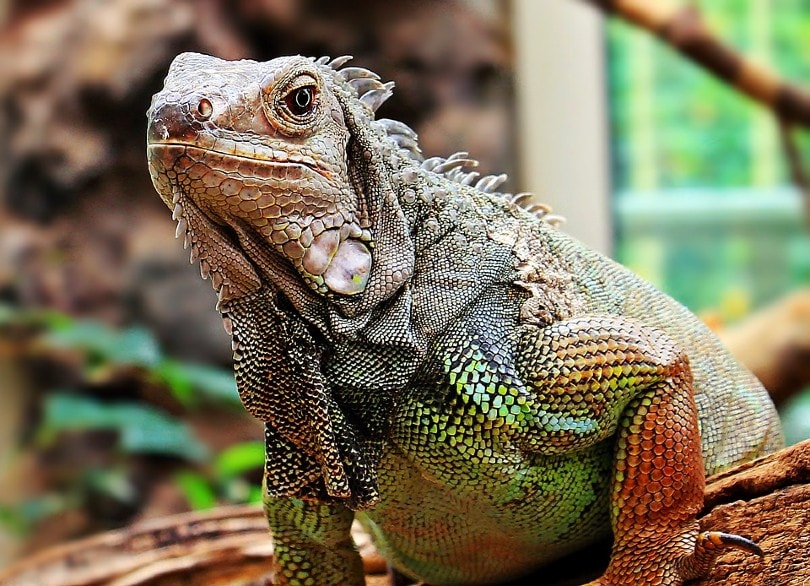Reptiles as pets isn’t a new phenomenon, but it is becoming more and more popular, especially among parents who want to teach their children some lessons about responsibility. These animals aren’t your typical cat or dog. They have particular needs that must be met for them to thrive. Of all the reptiles to choose from nowadays, it is hard to know which is going to be the right choice for you or your family.
Both the Chinese Water Dragon and Iguana are reptiles, but they differ in many ways. Water Dragons look like smaller iguanas and spend a large portion of their time swimming. They are found in tropical rainforests near water and up in trees. On the other hand, iguanas are native to South and Central America. They are one of the most famous lizard pets but are a huge commitment because of the high level of care.
If you’re considering bringing one of these animals home, don’t take the decision lightly. Find out all you can about them and what exactly goes into keeping them healthy and safe before making a decision.
Chinese Water Dragon vs Iguana An In-Depth Comparison
Deciding between a Chinese water dragon or an iguana as a pet reptile? Both can make exciting additions to a reptile enthusiast’s home, but they have key differences in appearance, size, care needs, temperament and more Read on for a comprehensive comparison of these intriguing lizard species to inform your choice
Appearance and Size: Dragonesque Differences
While superficially similar at a glance. Chinese water dragons and iguanas have distinct looks upon closer inspection
-
Iguanas grow much bigger, reaching 4-6.5 feet including their tails. Chinese water dragons max out around 2-3 feet in length. Iguanas have stockier, heavier builds compared to the more slender and streamlined Chinese water dragon.
-
Iguanas have a spiny dorsal crest and large dewlap under their chin. Chinese water dragons have a toothed vertebral crest and large, spiky horn scales running along their head and laterally flattened tail.
-
Iguanas come in a rainbow of colors like greens, oranges, pinks and greys. Chinese water dragons display gorgeous greens, purples and stripes. Both can change colors as they age.
-
The Chinese water dragon’s specialized flattened tail aids swimming while the iguana’s rounded tail provides balance and defense.
Habitat and Husbandry: Differing Needs
These species hail from different continents and consequently have distinct habitat requirements:
-
Chinese water dragons live along tropical forest rivers and streams in Southeast Asia. Iguanas occupy diverse habitats from South American rainforests to Mexico’s arid scrublands.
-
Chinese water dragons need large, vertically oriented enclosures with ample climbing areas, a large soaking water source and high humidity around 70-80%. Iguanas also require spacious cages focused more on ample floor space for horizontal movement and basking sites.
-
Ambient temperatures for Chinese water dragons should be around 80°F daytime and 75°F nighttime with a 95°F basking area. Iguanas enjoy slightly warmer 100°F basking spots and 80°F daytime ambient temperature.
-
Iguanas need higher humidity around 75% while Chinese water dragons do best at 60-80% humidity. Careful monitoring with hygrometers helps maintain ideal levels.
-
Chinese water dragons are mostly insectivorous, especially while young, and become more omnivorous with age. Iguanas strictly eat plant matter like greens, veggies and fruits.
Temperament: Handling and Interaction Differences
Iguanas and Chinese water dragons have contrasting temperaments and handling requirements:
-
Iguanas can become aggressive during mating seasons or if they feel threatened. Chinese water dragons may bite or lash out with their tails if they don’t get regular handling.
-
With frequent interaction from a young age, Chinese water dragons generally become quite docile and friendly. Iguanas tend to remain more moody and territorial even with extensive handling.
-
Chinese water dragons love climbing and exploring their habitat. Iguanas spend more time basking and are less active. Consider the activity level you desire in a pet reptile.
-
Male iguanas can be hostile and stressful for pregnant women due to hormonal cycles. This isn’t a concern with Chinese water dragons.
Social Behavior: Solitary or Companionable?
Iguanas are solitary creatures that become stressed and aggressive when housed together. Chinese water dragons can live peaceably in small groups under the right conditions:
-
Only keep one iguana per enclosure. They may tolerate separate enclosures in the same room. Never house iguanas together.
-
Chinese water dragons can cohabitate if ample space is provided, limited to one male per enclosure. Males fight with other males.
-
Monitor for signs of stress like appetite changes or lethargy if keeping Chinese water dragons together. Separate them if problems emerge.
Breeding and Egg Laying
Both species reach breeding maturity around 2-3 years old, with distinct reproductive patterns:
-
Iguanas mate once per year. Females dig nests and lay 20-40 eggs, incubating for 7-9 months underground. Hatchling survival rates are low.
-
Chinese water dragon courtship involves violent biting and tail lashing. Females lay 10-20 eggs in dug nests, hatching in 60 days. Like iguanas, many eggs fail to hatch or produce surviving offspring.
Ease of Care: Beginner Friendly or Advanced?
Chinese water dragons make better pets for novice reptile keepers compared to more challenging iguanas:
-
Chinese water dragons have more straightforward care needs like temperature gradients and humidity levels. Iguanas require meticulous environmental fine-tuning.
-
The vegetarian iguana diet simply involves offering a diverse mix of greens and chopped produce. Chinese water dragons need protein from live insects, especially while young.
-
Chinese water dragons don’t have aggressive seasonal hormonal surges. Iguanas require caution handling during breeding periods.
-
Regular handling helps Chinese water dragons stay tame. Iguanas remain more independently minded even with frequent interaction.
While Chinese water dragons are easier to care for, iguanas can still make rewarding pets for experienced, knowledgeable owners willing to meet their complex needs. Be sure you can fully commit to these intriguing but demanding creatures.
Key Points and Conclusion
To recap the key differences:
-
Iguanas get much larger, reaching over 6 feet long. Chinese water dragons stay under 3 feet in length.
-
Iguanas need huge cage floor space. Chinese water dragons require vertical climbing room.
-
Chinese water dragons will live together with space and one male per enclosure maximum. Iguanas must live solitary lives.
-
Chinese water dragons make better pets for beginners compared to more challenging iguanas.
-
Iguanas are herbivores. Chinese water dragons eat insects and some plant matter.
While requiring different care, both Chinese water dragons and iguanas captivate reptile lovers with their “dragonesque” looks and behaviors. Carefully factor in their respective sizes, housing, diets, handling needs and temperaments before deciding which magnificent lizard is the best fit for you. Either species can provide a lifetime of wonder and enjoyment with proper husbandry. Just be sure to thoroughly research the specific requirements of the reptile you choose!

Chinese Water Dragon Overview

There isn’t a single reptile that will ever become fully domesticated. Understanding how these animals react to their surroundings and getting them used to being handled makes the difference between an enjoyable experience and a commitment to an animal that won’t let you come close to it.
Young Chinese Water Dragons are better at becoming used to human interactions than adults. If they are not properly socialized with you or the other members in your house, they could get agitated and bite. These animals are prey in the wild and become easily frightened or startled. Try not to have them in a home that makes a lot of noise or put them around people or other animals that move too quickly.
An adequate enclosure is the most crucial part of owning a Chinese Water Dragon. Although small, these lizards need a lot of room to climb and swim. They require a minimum size tank of 40 gallons with lots of places to hide or climb branches. Most people use coconut fiber or Repti-bark as a substrate. Keep their temperature between 75°F and 100°F and use an incandescent light or ceramic heater to keep them warm.
Lighting is another crucial component of their tank. These lizards require UVB rays to help absorb vitamin D. Keep a full spectrum light on for 10 to 12 hours every day for them to bask in. Keep adult males separate from one another and do not ever put them in a tank with a different reptile species.

Signs of a healthy Chinese Water Dragon include clear eyes, active and alert personalities, full bodies and tails, clear noses, and regular eating habits. If they have a decreased appetite, weight loss, mucus in their mouth and nose, abnormal feces, or abrasions on their skin, then you need to take them to the vet right away. Common health issues include respiratory disease, gastrointestinal disease, and bone deficiencies.
Water dragons shed their skin, so make sure there is at least 60% humidity in the enclosure at all times to help them with this process. If they need additional help, bathe them in a large container of water or in a shed box.
Chinese Water Dragons are suitable for older kids or adults who won’t get jumpy around them and are looking for a small starter pet. Chinese Water Dragons are good pets to introduce to people who haven’t owned reptiles before.Pros
- Small
- Long life
- Minimal care
Cons
- Skittish
- Must be socialized from a young age
- Not good with other pets

Iguanas are one of the most sought-after reptile pets in the world, but that doesn’t mean that just anybody can take care of them. Iguanas have a lot of different ways of communicating and could be dangerous if you have no experience with them. They show a wide range of emotions like happiness, anger, fear, and agitation. They could bite, claw, or whip their tail if they are scared or uncomfortable with who is handling them.
Iguanas do well when being handled by humans from a young age. It is important to continue to handle them regularly, or they may become aggressive towards their owners or others. This isn’t to say they won’t make a good pet; they just need someone who understands them.
One of the most unexpected shocks to people is that their pet iguana reaches up to 7 feet in length as they mature. On top of that, they can get as heavy as 20 pounds. Their large size requires an even wider enclosure for them to live in, and most commercial enclosures don’t fit their needs. Adequate habitats are around 12 feet long, 8 feet tall, and 6 feet wide. You must keep it clean and remove waste, uneaten food, and old skin daily.
Iguanas want to bask in the sun all day and enjoy their enclosures being kept around 95°F. Do not ever let the tank temperature drop below 75°F. UVB bulbs are essential for giving them the necessary light exposure and should be kept on for 10 to 12 hours every day. They also require a humidity level of 70%, and you should mist your iguanas with clean water at least two or three times a day to keep their skin healthy and regulate the humidity.

The biggest health concern with iguanas is that they are known for carrying salmonella in their digestive tracts. Humans can acquire these bacteria simply from touching the reptile or the items inside of their enclosure. You must always wash your hands thoroughly before and after handling them to prevent the spread of diseases to children, pregnant women, or other immunocompromised people.
The most common health issue for iguanas is a kidney disease that results from dehydration. Most owners don’t regulate the humidity levels in their iguana’s environment. They must always have a moist environment and juicy greens and fruits for them to eat.
- See also: How to Take Care of a Pet Iguana
Iguanas are best suited for experienced reptile owners who are capable of providing them with all of their basic demands. They need mature individuals who won’t get scared if they act out and can handle them with confidence.Pros
- Trainable
- Long life
Cons
- Sometimes aggressive
- Large
- Require extra-large enclosure
At a Glance:Chinese Water Dragon
- Average length (adult): 2–3 feet
- Average weight (adult): 2–2.5 pounds
- Lifespan: 10–15 years
- Exercise: 1 hour per day
- Grooming needs: Minimal
- Family-friendly: Yes
- Other pet-friendly: No
Iguana
- Average length (adult): 6–7 feet
- Average weight (adult): 15–20 pounds
- Lifespan: 10–12 years
- Exercise: 1–4 hours per day
- Grooming needs: Moderate
- Family-friendly: No
- Other pet-friendly: No
Water dragon vs iguana
FAQ
Is a Chinese water dragon an iguana?
But don’t be fooled, this is not an iguana despite what’s stamped on its underside; this is actually a Chinese water dragon (Physignathus cocincinus).Jan 2, 2020
What’s the difference between a dragon and a iguana?
Physical Features of Bearded Dragons
Size-wise, they’re way smaller and lighter than iguanas, growing up to two feet (24 inches) long and weighing around 0.5 to 1.5 pounds. Thanks to their smaller size, bearded dragons don’t have the same enormous living space requirement as iguanas.
Are bearded dragons or iguanas better pets?
Iguanas are way larger, and aggressive by nature. Also, iguanas are herbivores, while beardies are omnivorous and become more herbivorous with age. Some iguanas have a flap under their chin, while beardies have stubble spikes. Beardies make better pets for beginner herp owners, That is just what I know, at least.
Are Chinese water dragons friendly?
-
Friendly and Social:Chinese Water Dragons are known for their inquisitive and robust personalities, and they often thrive in pairs or small groups.
-
Enjoy Handling:They generally enjoy being handled and are one of the friendliest lizards in the hobby, according to Pisces Pets.
-
Regular Handling is Important:Regular handling is essential to prevent them from becoming too aggressive, according to The Spruce Pets.
-
Potential for Aggression:If scared or threatened, they may bite or whip their tail.
-
Arboreal and Aquatic:They are arboreal lizards, meaning they like to climb in plants, on rocks, and in trees, and are also excellent swimmers, according to WebMD.
-
Not Beginner Reptiles:Despite their amenable temperaments, Chinese Water Dragons are not beginner reptiles. Their care requirements are specific, and they grow fairly large.
-
Housing:They require large enclosures with both aquatic and terrestrial features.
-
Diet:Their diet consists of crickets, mealworms, earthworms, grasshoppers, and even small feeder fish.
Are Chinese water dragons bigger than iguanas?
The Chinese water dragon is considerably lighter than the Iguana with Chinese water dragons weighing up to 1000g and Iguanas up to eighteen pounds. Iguanas are large lizards and can grow up to 4-6 feet in length. Chinese water dragons offer the dragon look in a smaller size and can grow up to 3 feet in length.
Do iguanas look like dragons?
Both the iguana and Chinese water dragon are beautiful reptiles that look like small dragons. When it comes to looks, they are both beautiful and attractive. When you buy an iguana you are choosing a life time companion. An iguana cared for properly in captivity can live up to twenty years and sometimes more.
How big does a Chinese water dragon get?
Chinese water dragons offer the dragon look in a smaller size and can grow up to 3 feet in length. The Chinese water dragon is considerably smaller than the iguana with 1-3 feet in difference between the reptiles. Active during the day, sleep at night. Active during the day and sleeps at night.
What do iguanas look like?
Some may have stripes, others a band on the tail. These dragons have colorful throats. Both the iguana and Chinese water dragon are beautiful reptiles that look like small dragons. When it comes to looks, they are both beautiful and attractive. When you buy an iguana you are choosing a life time companion.
Are Chinese Water Dragons Friendly?
Chinese water dragons are very friendly and love being handled once they get to know their owners. They too can become aggressive if threatened. Both of these reptiles make great friendly reptile pets for any reptile enthusiast. The iguana will become aggressive during mating season, when handled incorrectly or if they feel threatened.
Do Chinese water dragons eat insects?
There is no need to keep insects for feeding, where the Chinese water dragon enjoys a varied diet. Brumation is a type of hibernation that reptiles go through during the colder months, where they tend to sleep more, but will come out for food if hungry. Iguanas do not go through brumation.
